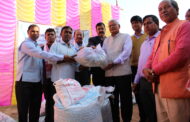Venkatesh R Thakur, D.N. Jha, Absar Alam, Monika Gupta, Jeetendra Kumar, Kalpana Srivastav and B.K. Das
India is the one of the hotspot of the mega biodiversity contributing 11.72 % to the global fish diversity. India ranks second in total fish production among top ten countries in the world with a total production of 13.7 MMT in 2018-19 of which 65 %has been contributed by the inland sector.
Out of which nearly 50 % of inland fish production comes mainly from culture fisheries, which constitutes 6.5 per cent of global fish production.
The fish production contributes around 1% to India’s gross domestic product and about 5.23 % share to the agricultural gross domestic product. The state of Uttar Pradesh having enormous freshwater assets in the form of river 7, 20,000 ha, wetlands and derelict waters 1.3 million ha and lakes 2.09 million ha.Total fish biodiversity of Uttar Pradesh contributes roughly 14.68% of the national fish biodiversity.
The total2246 numbers of finfish species has been recorded in India out of which 765 have been identified as freshwater fish species from various freshwater sources, of which 450 may be considered as small indigenous freshwater fish species.
What are SIF?
| Fig.1Freshly harvested SIF from Loni wetland |
SIF stands for small indigenous freshwater fish species and those fishes can grow to the maximum of 250-300mm size in mature or adult stage of their life cycle.As of about 57 fish species are considered as small indigenous fishes out of total fish species reported from Uttar Pradesh.
In India most of the rural population mainly depend on indigenous fishes as part of nutrition however very less is known about their nutrition, aquaculture, biology and conservation etc. due to laxity of research work.
Where do they live?
Small indigenous fishes manly live in rivers, tributaries, ?oodplains wetlands, ponds, lakes, freshwater streams, and paddy ?elds etc. and which act as major feeding and breeding grounds for the SIF. Many of the places this will be discarded from main catch and thrown on sides of the water body. It’s only because due to lack ok knowledge of the farmers/peoples, so it’simportant to make people aware about importance of SIF.
At some of the places SIF are dried and sent to the feed industry. As below shown the figure 2, SIF are being dried and after drying they will be sent for the further processing, very minimum is being used in the nutrition by the fishers.
Small indigenous fishes kept for drying at Loni wetland
Nutritional value
The small indigenous fishes are important because they offer essential nutrients such as proteins of good quality, fattyacids particularly the PUFA, vitamins, minerals and trace elements. Some commonly consumed, small freshwater fish species like Amblypharyngodon mola, Parambassis ranga, Osteobrama cotio, Esomus danricus have been found to contain high amount of preformed vitamin A in the form of retinol.
Thetraditional communities in eastern and northeast India haveindigenous knowledge about the health benefits of SIF, such as mola(Amblypharyngodon mola)is often included in the diet of pregnant and lactating mothers, for its nutritive value. Therefore combination of a small quantity of small indigenous fishes can significantlyincrease the biological value of the diet andcontribute to noteworthyenhancements in the nutritional security.
Hence more research work needed for their diversification, culture practices and also to know their breeding potential. The law should be in place for unauthorised fishing and catching of brooders and juvenile fishes, which will help them to establish their population in the ecosystem and directly help in restoration and conservation of these fishes. Through public awareness programs, people need to be sensitised about importance of the small indigenous fishes and their nutritional importance as well as role in the livelihood security.
Some of the examples of SIF:

Puntius chola(puti) Osteobrama cotio(gurda)

Ompok bimaculatus (Jalkapoor)

Mystus sp (Tengra)
(Venkatesh R Thakur, D.N.Jha, Absar Alam, Monika Gupta and Jeetendra Kumar are Scientists, Kalpana Srivastav is CTO and B.K.das is Director at ICAR- CIFRI. Views expressed are personal.)
(Please share your experience, interesting news articles and case studies at aquapostnews@gmail.com)






